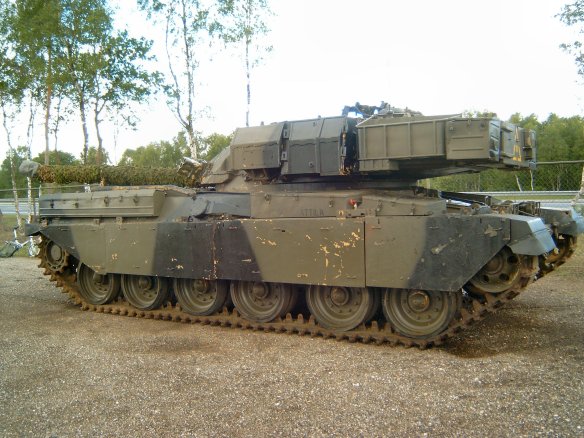Chieftain Mk.11: Mark 10 upgrade, searchlight replaced with the Thermal Observation and Gunnery System (TOGS), manufactured by Barr and Stroud.
Like its European competitors, Chieftain found a large export market in the Middle East, but unlike Centurion, it was not adopted by any other NATO or Commonwealth countries.
Chieftain proved itself capable in combat and able to be upgraded with enhancements both for overall improvement and to meet local requirements. The marque was continuously upgraded until the early 1990s when it was replaced by Challenger 1. The final Chieftain version used by the British Army until 1995, incorporated “Stillbrew” armour named after Colonel Still and John Brewer from the Military Vehicles and Engineering Establishment (MVEE), the Improved Fire Control System (IFCS) and the Thermal Observation Gunnery Sight (TOGS).
The initial Chieftain production mark was the Mk 1 which served in 40 delivered examples utilized primarily for trials and tanker training beginning in 1965. The Mk 2 became the initial service-ready model and these were supplied with 650 horsepower Leyland engines. A new commander’s cupola was devised, an uprated engine introduced and additional equipment added to make the Mk 3 variant. The final definitive Chieftain production model became the Mk 5 and these added NBC protection units at the turret bustle as well as further uprated engines.
The Mk 6, Mk 7, Mk 8 and Mk 9 marks were essentially upgrades of earlier production models that introduced improved engines. The following Mk 10 was based on the Mk 9 upgrade and included the “Stillbrew Crew Protection Package” (SCPP) along the turret as well as an improved fire control system. The Mk 11 was itself an upgrade of the Mk 10 which saw the original IR/white light searchlight replaced with the Barr & Stroud “Thermal Observation and Gunnery System” (TOGS). TOGS allowed for adverse weather and night fighting capabilities which expectedly broadened the tactical scope of Chieftains for the better. The Mk 12 and Mk 13 variants were proposed Chieftain upgrades that would have featured additional improvements throughout but these marks were done in by the arrival of the excellent Challenger 2 series main battle tank.
The first model was introduced in 1967. Chieftain was supplied to at least six countries, including Iran, Kuwait, Oman and Jordan. An agreement for sales to Israel was cancelled by the British Government in 1969, despite considerable Israeli technical and tactical input into the development of the tank, especially in desert environments, and the use of hull-down to maximum effect in the final design. This experience spurred the creation of the indigenous Israeli Merkava, the development programme of which was led by General Israel Tal, who had worked closely with the British in the Anglo-Israeli Chieftain project. The largest foreign sale was to Iran, which took delivery of 707 Mk-3P and Mk-5P, 125–189 FV-4030-1, 41 ARV and 14 AVLB before the 1979 revolution. Further planned deliveries of the more capable 4030 series were cancelled at that point. The tank was heavily used during the Iran–Iraq War of 1980-88 with mixed results, engine breakdowns being a common issue. Chieftains participated in the biggest tank battle of the war in early 1981. Iran lost 200 Chieftain and M60A1. In return, Iraq lost 50 T-62 tanks.
